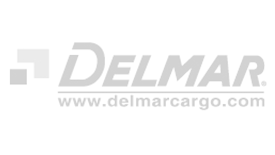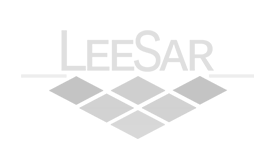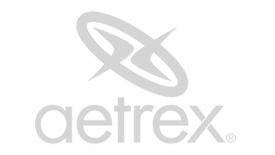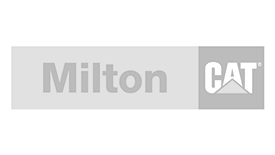What is distribution management?
Distribution management is the coordination and supervision of the distribution of goods. It includes planning and implementing transportation and storage from their origin to their points of consumption. It also includes the management of core operations and data associated with these processes.
Why is distribution management important?
An effective distribution management strategy is critical to a distributor’s operations. It defines the success and profitability of a business and determines the quality of service an organization provides to its customers. If the distribution cycle is not managed well, it will directly affect the bottom line. All touchpoints will suffer; starting with lack of data visibility to make informed decisions, inaccuracies at the purchasing and procurement level, poor pricing and lowered margins, delayed or inaccurate delivery of products, and unhappy customers resulting in an inability to remain competitive and grow.
What are the main distribution management channels?
The main distribution management channels include wholesalers, retailers, distributors and e-commerce operators. Here is a closer look at how distribution management functions within each of these channels.
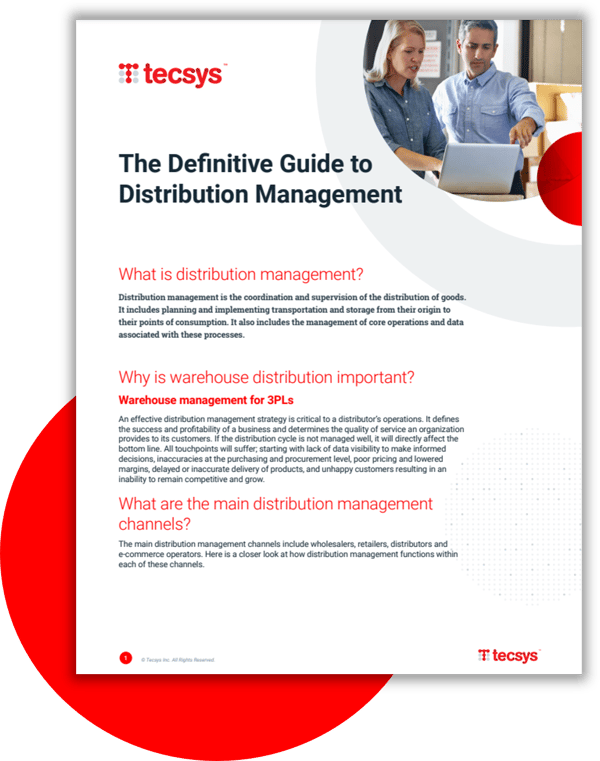
E-book: The Definitive Guide to Distribution Management
Download a PDF version of this definitive guide to distribution management to take your operations from good to great.
Download nowWhat are the objectives of distribution management?
There are three objectives or "pillars" of distribution management distributors must strive to accomplish: core operations and data management, business process automation and improved business outcomes.
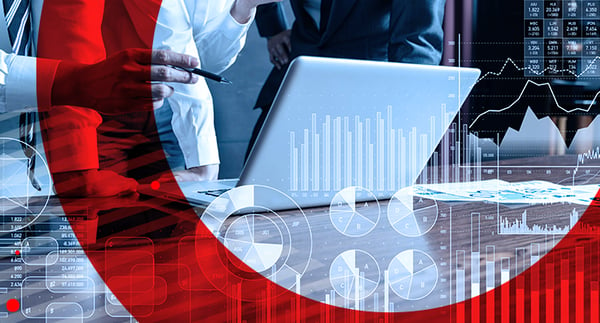
Core operations and data management
The first objective of distribution management is to manage the cycle from procurement to sale and have visibility into the core operational data. This data includes inventory levels, customer orders, vendor orders, sales data, financial data and more. Distribution management systems are used to provide visibility into all these aspects of an organization.
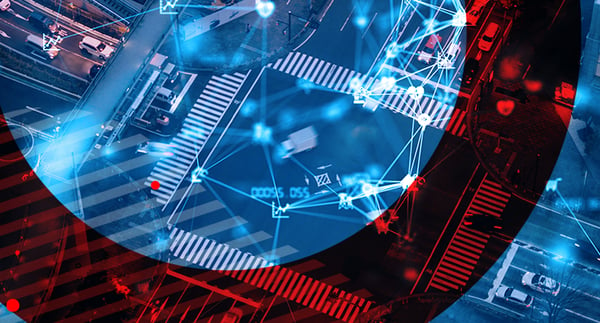
Business process automation
The second objective of distribution management is to automate distribution processes. This automation can include tasks such as ordering inventory from vendors, generating customer invoices, and processing customer payments. Digital transformation provides the ability to automate their processes through a centralized platform for all distribution operations.

Improved business outcomes
Ultimately, distributors must hit specific KPIs that represent improved business outcomes. This can be accomplished by reducing costs, improving customer satisfaction and increasing revenues. A distribution management system can help businesses achieve these improved outcomes by helping them to deliver on their defined KPIs.
What activities occur during distribution management?
In order to accomplish distribution management objectives, it’s important to have a holistic view of the business. Access to real-time data in demand planning, enhanced inventory management and financial management are all key activities that improve decision-making and lead to better business outcomes. Here is a closer look at what's possible in these three areas.

Demand planning
Demand planning is the process of estimating the demand for various products in their respective markets with the hopes of maximizing return on investment and minimizing excess inventory. Demand planners can increase forecast accuracy, reducing wasted time and money and optimizing inventory availability. Staff can also develop what-if scenarios to evaluate the impact of changes in distribution operations.

Inventory management
Inventory management is the process of tracking inventory starting from manufacturers to warehouses and to point of sale. It’s a balancing act that requires constant visibility into a company's entire product portfolio — not simply what's in stock. Distribution management systems are designed to provide inventory managers with data to optimize inventory levels, reduce their inventory costs and improve order cycle times.

Financial management
Financial management is the process of managing, organizing, forecasting and controlling the financial activities of the business. Modern CFOs and VPs are looking to do more than simply monitor business performance. Using distribution management systems, they can leverage evidence-based information and analytics to make calculated business decisions, stay compliant, have a pulse on their financials anytime, anywhere, and increase profitability.

E-book: Keep Calm and Demand Plan
Download this e-book to find out how to maximize the benefits of demand planning – lower acquisition costs, lower carrying costs, less money invested in inventory, higher customer service levels – and reap the rewards.
Download nowFactors that influence distribution management
Optimizing one's systems and processes represents only one dimension of distribution management. Macro factors including the growth of both B2B and B2C e-commerce, the globalization of supply chains and the rise of omnichannel distribution present challenges and opportunities for modern distribution as well.
B2B and B2C e-commerce
Shift in consumer behavior and the rapid growth of digital commerce in both B2B and B2C is reshaping distribution. Consumers want anytime, anywhere access and e-commerce opens up endless channels for distributors and retailers to sell their products. Modern distribution management systems provide a bridge between all the touchpoints to help distributors provide a seamless customer experience across multiple channels.
Globalization of supply chains
Expanding operations into new markets can lead to increased complexity in the distribution process. Sourcing from foreign markets themselves can also lead to new challenges, such as communication barriers, financial or reporting differences, and keeping up with government regulations. A distribution management system that is built for global distribution operations can provide the necessary data and processes to effectively manage these complexities.
Omnichannel distribution
For distributors, omnichannel distribution is characterized by the need to provide a consistent customer experience across all channels while managing inventory as a single pool. An end-to-end distribution management platform can help businesses achieve real-time inventory visibility and seamless order orchestration across all channels.
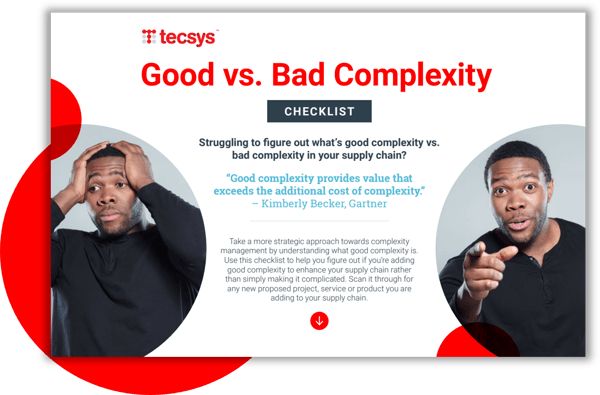
Checklist: Good vs. Bad Complexity
Use this checklist to help you figure out if you’re adding good complexity to enhance your supply chain rather than simply making it complicated.
Get checklistDistribution management challenges
Distributors are plagued by margin erosion due to errors and inefficiencies — internally and in their extended supply chains. Challenges arise that push them to improve order cycle times while reducing inventory costs, rather than simply compete based on price alone. Here is a closer look at distribution management challenges most common to distributors today.
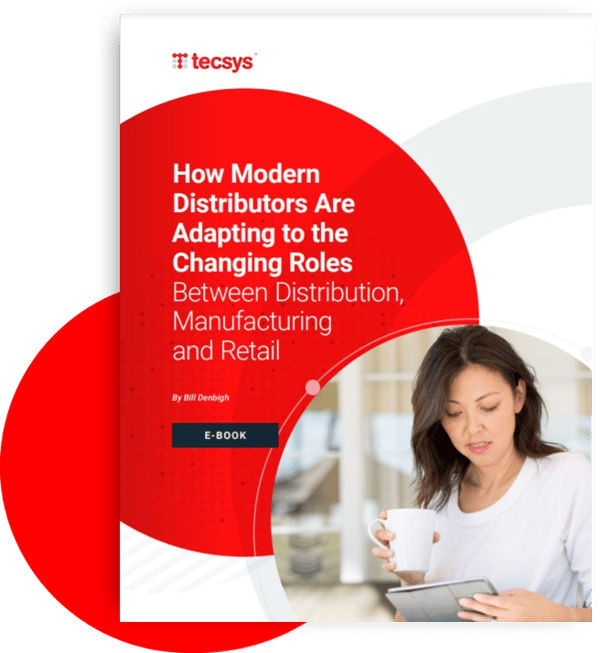
E-book: How Modern Distributors Are Adapting to the Changing Roles Between Distribution, Manufacturing and Retail
Download this e-book about the exciting opportunities in new warehouse, distribution and sales models for distributors of consumer products.
Download nowDistribution management strategies
Modern distributors have arrived at a point where manual processes and "quilted," strung-together solutions no longer meet customer and market demands. Growing and scaling within modern supply chains requires a modernized distribution management approach to become a backbone of distributors' operations.
Transforming a supply chain into a true “value chain” requires modern distribution management software that can align with demand-driven strategies and enable team members to focus on value-adding tasks. End-to-end distribution management platforms provide the comprehensive capabilities needed to digitize and automate distribution center processes across all channels to meet these requirements. Touching upon every facet of the organization, a distribution management system pulls data together to provide a holistic view of the operations and health of the business.
What are the types of distribution management software?
There are different types of systems for distribution management, each with unique capabilities and both physical and digital requirements. Here is a closer look at the most common distribution management systems today.
What is distribution ERP software?
Distribution ERP, or distribution enterprise resource planning software, helps businesses manage and automate their core distribution operations. Distribution ERP systems are designed specifically for distribution organizations and offer a complete set of capabilities for managing distribution operations.
Today, nearly 80% of organizations that have implemented an ERP solution have plans to replace or upgrade their current solution, Gartner reports.* Distributors in particular need more modern distribution ERP systems to manage their core operations and data, as well as enable portals for their vendors, customers and sales partners to maximize efficiency. Traditional ERP systems are not designed specifically for distribution organizations and lack the comprehensive distribution capabilities of an end-to-end distribution ERP platform.
*Gartner, "Tool Business Capabilities Model for ERP," May 2022
Why do you need distribution ERP software?
For distributors, an end-to-end ERP solution is an invaluable business resource. It gives them visibility into every facet of their operations so they can make better decisions, turn around customer requests more quickly and stay ahead of their competitors.
ERP is key to providing visibility and meeting business objectives, such as growing and scaling capabilities, identifying problem areas and profit opportunities, optimizing processes in real-time and enabling practical access to data to improve real-time decisions.
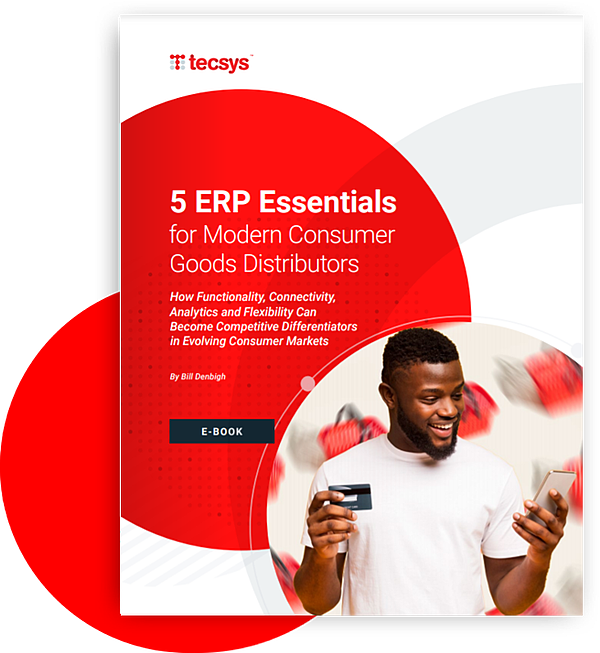
E-book: 5 ERP Essentials for Modern Consumer Goods Distributors
Download this e-book to find out what essential functionalities and capabilities you need from your distribution ERP software to run your operations and drive your business forward.
Download nowBenefits of distribution management
There are competitive advantages to end-to-end distribution management, especially when utilizing a leading distribution ERP software. Additionally, these benefits can help businesses make better use of data and analytics to improve decision-making.
Which companies should buy distribution ERP software?
Enterprise and global distributors are not the only types of companies that can benefit from distribution ERP solutions. Any distribution company that is looking to improve efficiency and optimize its operations can benefit from a distribution ERP system.
Small and mid-sized distributors are often the biggest beneficiaries of distribution ERP software because they lack the resources of larger enterprises. They also may have more complex distribution processes and can benefit greatly from the increased visibility and control that a distribution ERP system provides.
Meanwhile, large distributors may have multiple global divisions, each of which operates independently. With adaptable distribution ERP software, these divisions do not have to conform their processes to fit the software; rather, the software can be adapted to fit their individual processes. This allows each division to meet its needs while still benefiting from the centralized management of a distribution ERP system.
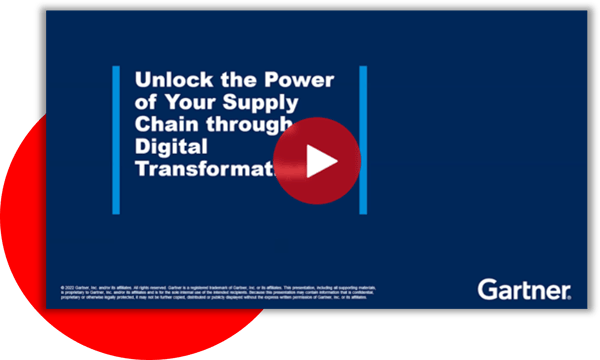
Webinar: Unlock the Power of Your Supply Chain through Digital Transformation
Access this on-demand webinar with Gartner’s Supply Chain Analyst, Joanne Joliet, and SupplyChainBrain’s Editor-in-Chief, Bob Bowman, as they bring clarity on the impact digital supply chain transformation will bring to your organization.
Watch nowKey features of distribution ERP software
A modern distribution ERP provides the functionality necessary to meet the challenges of today’s supply chain ecosystem. Here are three key features of modern distribution ERP software beyond demand planning, inventory management and financial management as mentioned above.
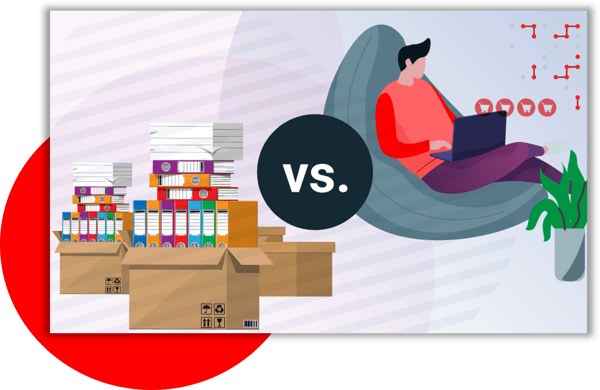
Infographic: Traditional ERP vs. Modern Distribution ERPs
Find out why it might be time to find a modern distribution ERP system to meet your needs in today’s world.
GET INFOGRAPHICDistribution ERP software trends
The distribution ERP software market is growing rapidly, and new features and functionality are being added to these systems all the time. Here are some of the latest trends in distribution ERP.
Cloud-native distribution ERP
Cloud systems are becoming more popular, as they offer greater flexibility and scalability than on-premises systems.
Security
The need to protect and continuously manage data security is quickly becoming a top priority for distributors looking to resolve issues before it impacts the business.
Mobile apps
Mobile distribution ERP apps are becoming more common, as they allow users to access data and perform tasks from anywhere, at any time.
Predictive analytics
Modern end-to-end platforms include predictive analytics functionality to help distributors forecast demand and plan for future needs.
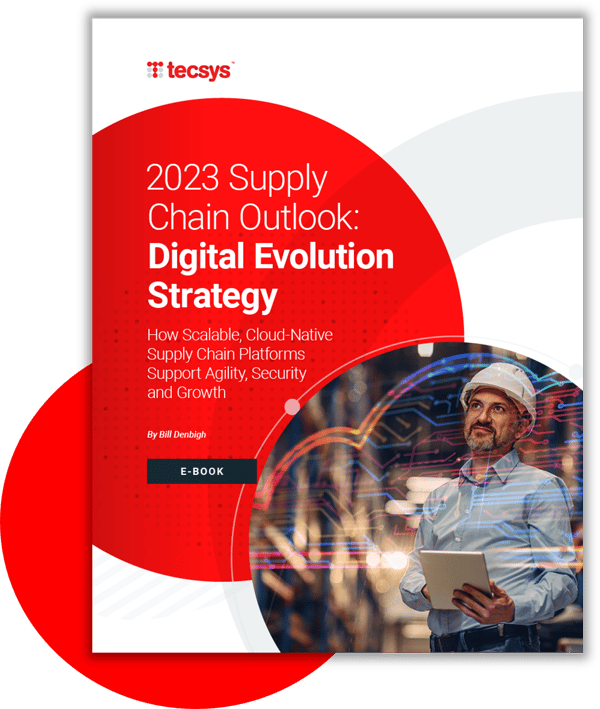
E-book: 2023 Supply Chain Outlook: Digital Evolution Strategy
Download this e-book to learn more about how introducing innovative technologies can present ample opportunities for your supply chain platform to evolve.
Download nowHow to choose a distribution management system
When choosing a distribution management system, it is important to consider your specific needs and business goals. Here are five differentiating factors to keep in mind.
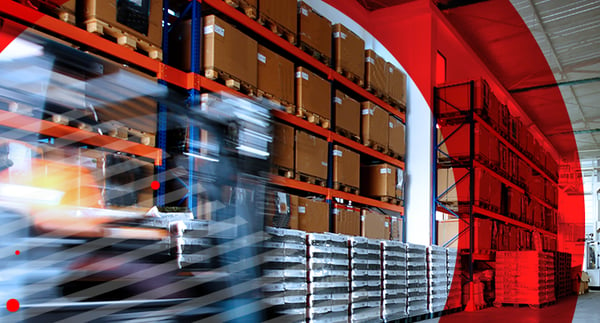
Order processing
With traditional distribution management platforms, there are fixed processes for all types of order processing. With an end-to-end platform, distributors can manage orders in the most appropriate ways for their business. For example, manual orders can be processed one way and electronically integrated orders can be processed via a different workflow.

Integration agility
Traditional ERPs require that distributors manually integrate CRM, product information management (PIM) and other specialized solutions via manual coding. Modern distribution ERPs provide an open connection to easily integrate with specialized, best-of-breed solutions.

Financial performance
Traditional distribution management systems require that distributors use these systems’ built-in financials. But with modern, end-to-end platforms, distributors can choose to omit the built-in financials and use best-of-breed solutions that meet their specific needs instead.

Business intelligence
Traditional distribution management systems provide access to only basic reporting features. Modern distribution ERP systems provide access to baseline distribution analytics with best-practice key indicators, predefined to support distributors' own preferred business intelligence (BI) solutions.

Maintenance
Any maintenance changes or updates to traditional distribution management systems require expensive manual code-based modifications. With modern distribution management systems, there are no-code or low-code extensions that allow distributors to build innovative workflows without losing the upgrade path.
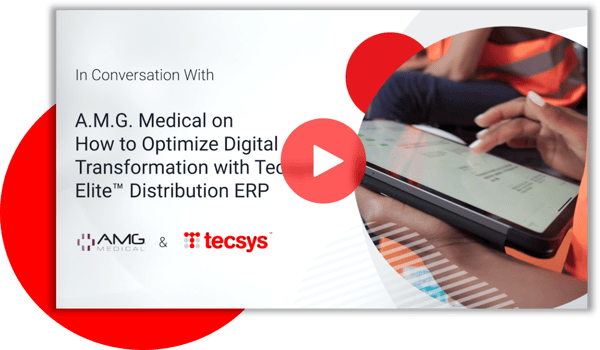
In Conversation With: A.M.G. Medical
Access this interview to learn more about how A.M.G. Medical utilized distribution ERP software to optimize its digital transformation.
WATCH NOWElite™ Distribution ERP
Tecsys’ Elite™ Distribution ERP covers the entire distribution spectrum, including integrated financials and enterprise reporting. To stay on top of things, Elite™ Distribution ERP’s scalable transactional engine supports all cross-functional activities — anytime, anywhere — so you don’t miss a thing. It gives you visibility into every facet of your operations so you can respond to “issues” ahead of time and make the right adjustments whenever they’re needed.
Elite™ Distribution ERP includes:
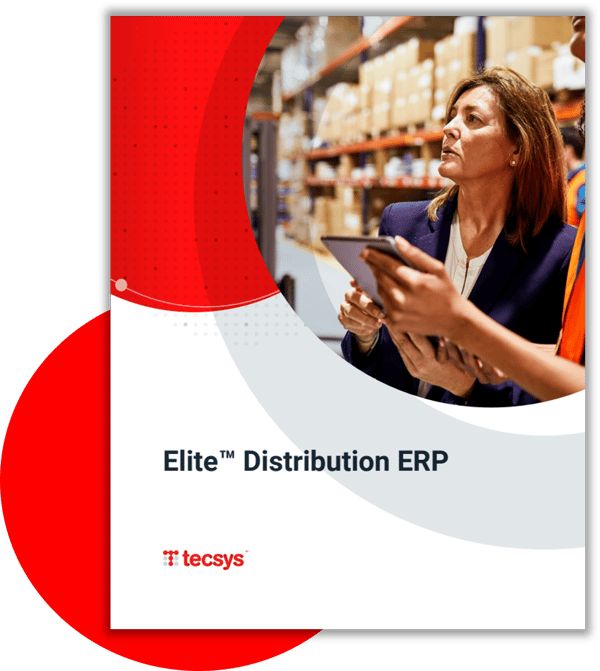
Brochure: Elite™ Distribution ERP
Find out how Tecsys’ Elite™ Distribution software will give you visibility into every facet of your operations so you can respond to “issues” ahead of time and make the right adjustments whenever they’re needed.
Download nowAbilene Machine
Elite™ Distribution ERP enables Abilene Machine to grow sales while lowering inventory levels.
Abilene Machine is one of the largest retailers of recycled, remanufactured and new replacement parts for tractors and combines. To keep up with year-over-year annual growth of five percent and continue to meet its customer promise of open, honest service, Abilene Machine needed an effective method of demand planning and forecasting that could also handle foreign-sourced parts with long lead times.
Abilene Machine implemented Tecsys’ Elite™ Distribution ERP system to gain full visibility into inventory procurement, production planning and order fulfillment processes, strengthening customer relationships and improving internal efficiency.

With its upgraded Tecsys software now in place and running on Tecsys’ cloud infrastructure, Abilene Machine can continue to meet customer expectations while supporting aggressive growth strategies.
The company’s adoption of just-in-time replenishment for independent and dependent demand and right-sizing of safety thresholds has allowed them to grow sales without overinvesting in inventories.
Read Success StoryWalter Surface Technologies
Elite™ Distribution ERP helped Walter Surface Technologies to achieve 98% same-day ship and significantly improve order-to-cash cycle.
Walter Surface Technologies is a global leader in surface treatment technologies delivering high-performance abrasives, tooling, power tools, chemical solutions and welding process solutions specifically designed for the metal working industry. Walter’s unique challenges encompass the full supply chain management cycle; from development to distribution and customer services across North America, Europe and South America, to improve the purchase-to-pay and order-to-cash cycles.

Walter selected Tecsys’ Elite™ Enterprise solutions which included Elite™ Distribution ERP, Elite™ WMS, Elite™ TMS and Elite™ Analytics. Walter realized significant efficiencies and cost savings such as increasing fill rate to 98%, reducing billing cycle by 24 hours, increasing warehouse labor productivity by up to 15%, and being able to do more with less, even when they grow.
Read Success Story



